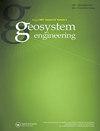Quantifying the criteria for classification of mineral resources and reserves through the estimation of block model uncertainty using geostatistical methods: a case study of Khoshoumi Uranium deposit in Yazd, Iran
IF 1.1
Q3 GEOSCIENCES, MULTIDISCIPLINARY
引用次数: 7
Abstract
ABSTRACT Investments and progress of mineral projects depend on the quantity (tonnage) and quality (grade) of mineral resources and reserves. This study examines the impact of various criteria used in the classification of mineral deposits or parameters defining these criteria. The data used in this study include the uranium assay analysis from 127 exploratory boreholes, which were then subjected to a three-directional variography after statistical studies to identify regional anisotropy. A grade block model was built using the optimal parameters of variograms and with the help of kriging estimator. Then, by using different methods of estimating the block model uncertainty including kriging estimation variance, block error estimation, kriging efficiency and slope of regression, classification of mineral reserves was carried out in accordance with the JORC standard code. Based on different cut-off grades, the tonnage and average grade were calculated and plotted. An innovative quantitative method based on the distribution function of the mentioned parameters and the fractal pattern of separation of populations was used for the classification of mineral reserves. The existence of the least difference between the use of standard and fractal patterns in the slope of regression method indicated less error and was a proof of more reliable results.利用地质统计学方法通过估算区块模型不确定性来量化矿产资源和储量分类标准:以伊朗亚兹德Khoshoumi铀矿床为例
摘要矿产项目的投资和进度取决于矿产资源和储量的数量(吨位)和质量(品位)。本研究考察了矿床分类中使用的各种标准或定义这些标准的参数的影响。本研究中使用的数据包括127个勘探钻孔的铀含量分析,然后在统计研究后对这些钻孔进行三向变差分析,以确定区域各向异性。利用变差函数的最优参数,借助克里格估计,建立了品位块体模型。然后,通过使用不同的方法来估计区块模型的不确定性,包括克里格估计方差、区块误差估计、克里格效率和回归斜率,根据JORC标准代码对矿产储量进行了分类。根据不同的截止品位,计算并绘制了吨位和平均品位。基于上述参数的分布函数和种群分离的分形模式,采用了一种创新的定量方法对矿产储量进行分类。在回归方法的斜率中,标准模式和分形模式的使用之间存在最小的差异,这表明误差较小,并且证明了更可靠的结果。
本文章由计算机程序翻译,如有差异,请以英文原文为准。
求助全文
约1分钟内获得全文
求助全文

 求助内容:
求助内容: 应助结果提醒方式:
应助结果提醒方式:


